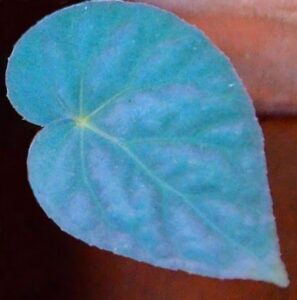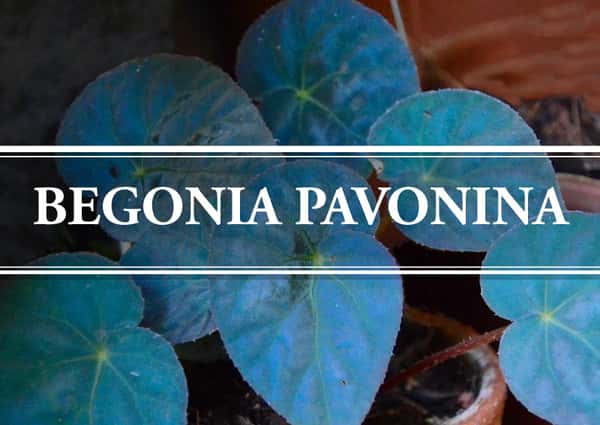Are you looking for a unique indoor plant with bright foliage? We get you covered! A shout out for one of the most gorgeous plants, the Begonia Pavonina plant.
The heart-shaped, bright-green leaves with reddish undersides get a prominent bluish shade in light. This combination of dark-green and blue makes this plant popularly known as the Peacock Begonia.
These natives of the under-lit mountains of Malaysia change their shade to enhance the absorption of light. This is known to help them combat the low light conditions of their native habitat. Sounds interesting, eh?
You can grow them indoors in pots, containers. Moreover, the average size of around 16 inches makes them a nice choice for terrariums. Want to know more? Please keep reading to learn about the care and maintenance of the rare Pavonina Begonia plant.
Begonia Pavonina Classification
Family: Begoniaceae.
Genus: Begonia.
Species: B.pavonina.
Features of the Begonia Pavonina Plant

Size:
This plant can get about 16 to 25 inches in size. This miniature size makes them perfect for terrariums and small spaces.
Leaves:
- These round heart-shaped leaves are deep green to greenish-brown. When grown in under-lit places, the instinct becomes prominent to enhance light absorption. Light hitting the surface of leaves on different angles gives a specific bluish tint.
- Each mature leaf is about 3 to 5 inches in size.
Flowers:
Light pinkish flowers grow to beautify the plant in spring and summer.
Toxicity:
All of over 1000 Begonia plants and their species are safe for humans. However, the insoluble oxalate crystals in the foliage are toxic for animals. Thus, keep the plants out of the reach of your pets including cats and dogs.
Begonia pavonina Care
A typical Begonia, suitable for everyone including the beginners.
Quick Guide:
Water: Moderate (Water after the upper 2 inches gets dry)
Sunlight: The bright indirect sun.
Humidity: prefers higher but tolerates lower levels.
Fertilizer: Mild concentration in the growing season.
Let us learn the details of “how to grow the Begonia pavonina plant?”
Water Requirements
It comes with a moderate water requirement, common for the majority of the Begonias. The soil should be moist but not over-wet or soggy. Water the soil right after the upper 2 inches get dry.
The frequency is determined by the temperature and sunlight availability. Higher temperature increases the water requirement for the plant. In spring and summer, about once or twice a week is enough. While at the peak of summer, you may need to water about thrice every week.
The watering requirement of the plants usually decreases with the fall in temperature. So, it will be enough to water once every three weeks for fall and winter. Soggy and over-wet soil can suffocate the roots. Furthermore, they can cause issues like fungus and root rot. Thus, avoiding over-watering is as difficult as under-watering.
Sunlight Requirements
In the natural habitat, these plants grow in diffused light. So, the bright indirect sun is ideal for this plant. Direct sun can scorch out the delicate foliage. So, make sure to place them wisely. You can grow these around well-lit south or a north-facing window where the sun doesn’t reach the plant directly.
It is important to mention here that artificial light is not enough for this Begonia. So, make sure to place them in sun.
Soil Requirements
Just like the majority of Begonias, this one too needs well-draining soil. You can use a common houseplant growing mixture.
Moreover, a mixture of sphagnum moss and perlite in 2:3 is also a nice option. Sphagnum moss allows good drainage while the perlite absorbs water to provide the roots in the future. Coming towards the PH, slightly alkaline soil with a PH between 5 and 7 is ideal.
Temperature Requirements
The ideal temperature range for the majority of the Begonias is between 55°F to 75 °F (13 to 24 °C). The Peacock Begonia loves to be at a moderate temperature. Hotter temperatures especially hot summer nights can put a troll on the plant’s foliage. Similarly, cold temperatures are also unsuitable for it. So, make sure you are placing them at a moderate temperature. Moreover, don’t forget to transfer the outdoor peeps to warm indoor spots before the fall.
Humidity Requirements for Begonia Pavonina
Your Begonia loves to be in a humid atmosphere. As an estimate, a moisture level of 60 to 80% is ideal for this plant. On dry days, you need to enhance the moisture level around your plant. You can follow any of the following methods;
Using a pebble-water tray under the pot is an easy way. Just fill a shallow pot with water and place some pebbles in it. Keep the water level below the pebbles. Now, place the pot on the pebbles. The water will evaporate from the base to fulfil the humidity requirements of the plant.
Other options include using a humidifier or simply grouping the plants. You can also mist the foliage once in a while. However, make sure the plant is staying well-ventilated. Foliage staying wet for long can attract pests and root rot.
Fertilizer Requirement
Use a common houseplant fertilizer with a balanced nutrient ratio once a month in spring and summer. The product with a 10% concentration of Nitrogen, Phosphorus, and Potassium is recommended. Moreover, it should also include micro-nutrients like Calcium, copper, magnesium, and molybdenum. Always use a mild concentration, preferably half of the stated dose.
Low temperatures diminish the nutrient requirement of the plant. Thus, the end of the summer is the ideal time to stop using fertilizer.
Pot Requirements
Use a small pot with drainage holes at the base.
Re-potting Requirements
An annual repotting is ideal for the plant. The plant getting larger for the pot or roots growing out from the drainage holes are the main signs.
Use a pot only one size(few inches) larger than the previous one. This will combat any excess stress on the roots due to the large size of the plant. Moreover, avoid being harsh and frequently repotting the delicate foliage. The pleasant month of March in the spring season is the ideal time for repotting.
Pruning Requirements
Remove the damaged and unhealthy leaves from the plant. This will ensure a good appearance and healthy growth for the plant.
Begonia pavonina Propagation
Do you want to make some more Pavonina plants? Planting the stem cuttings the easiest method to make some new Begonias.
Propagation by Stem-cuttings:
The pleasant days between mid-spring and mid-summer are ideal for planting the cuttings.
Method:
- Cut a few stem-cuttings, each about 8 inches long. Cut just below the leaf node with at least two leaves at the upper end. If there are any leaves at the lower end, it is better to remove them.
- Plant these cuttings about 3 inches deep in the moist growing mixture. You can use sphagnum moss, soil, or any common houseplant growing mixture.
- Place the setup in medium to the bright indirect sun. Additionally, keep the soil moist and water right after the upper layer gets about 70% dry.
- Roots start developing after the initial 3 weeks. This will be followed by baby shoots protruding out around the 4th week.
- After about three months, simply follow the Begonia pavonina Care as mentioned in the previous section.
Water Propagation:
Don’t forget to change the water every week. This is essential to avoid fungus growth.
Once the root system is developed, you can transfer the baby plant to soil or an appropriate growing mixture.
Propagation by Seeds:
You can simply get a bag of Begonia pavonina seeds to try the seed-propagation.
- Sow about 5 to 15 seeds on the top of the moist growing mixture. This could be a common houseplant mixture or sphagnum moss.
- Place the set up at a warm well-lit place with an ideal temperature around 23 °C.
- Keep the soil moist by spraying a mild mist of water. Wait for about 4 to 5 weeks of the germinating period and you will see tiny shoots protruding out from the seeds.
Related Posts:
Summary
Begonia pavonina is a rare rhizomatous plant belonging to Malaysia. The plant gets attention for its unique bright foliage. The dark-green leaves get a prominent bluish tint in light. This is the natural mechanism of the plant to increase the absorption of light.
This rare plant can get about 16 to 25 inches tall. Moreover, it is a nice choice for indoor pots and terrariums. Bright indirect light, frequent watering, and high humidity are what you need to keep the plant happy. Finally, let us talk about toxicity. The plant is safe for humans but toxic to animals. So, make sure your Peacock Begonia is not in the reach of your beloved pets.

